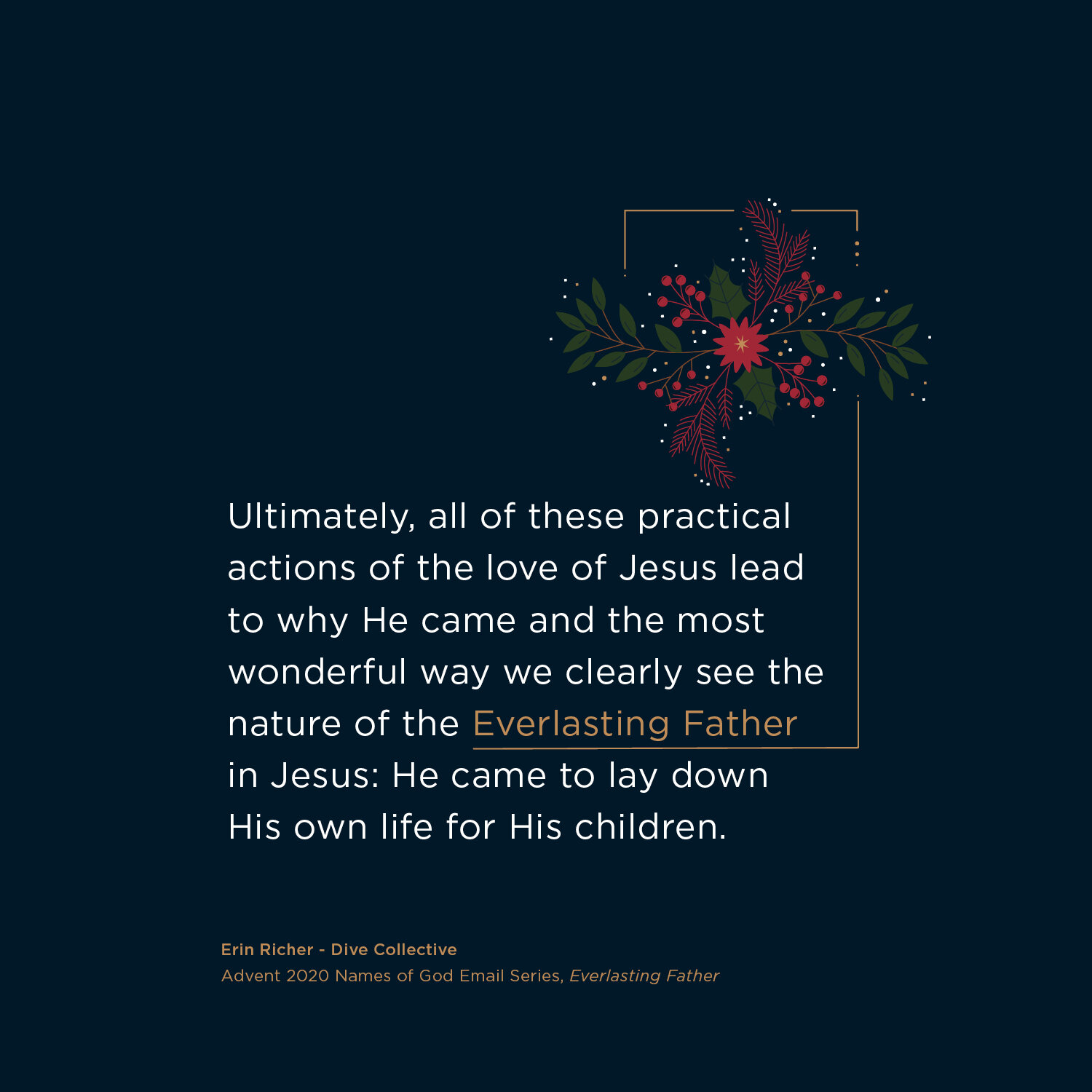Everlasting Father
Written by Erin Richer
Jesus as Everlasting Father. How do I think through Jesus as Everlasting Father and still maintain the truth that the Trinity is three in one? Three separate beings in both person and role, yet one?
The everlasting part is easy. We know He was there at creation (John 1:3, 10; Colossians 1:1). We know Jesus is eternal—existing before time (John 8:58), now seated at the right hand of God (Hebrews 10:12), the same yesterday, today, forever (Hebrews 13:8).
But how do we see Jesus as Father without confusing the roles that the separate persons of the trinity fulfill?
When we look at God and His relationship to the Israelite nation in the Old Testament, it’s not difficult to notice ways in which He relates to them as a Father. He loves them, leads them, teaches them, disciplines them, redeems them. Over and over, we see God purchasing His people back from the sinful ways and false gods to which they turn.
The author of Hebrews spends much of His time establishing the priesthood and kingship and diety of Jesus Christ. He says this of Jesus’ relationship to God the Father:
“Long ago, at many times and in many ways, God spoke to our fathers by the prophets, but in these last days he has spoken to us by his Son, whom he appointed the heir of all things, through whom also he created the world. He is the radiance of the glory of God and the exact imprint of his nature, and he upholds the universe by the word of his power. After making purification for sins, he sat down at the right hand of the Majesty on high” (Hebrews 1:1-3).
Jesus is the exact imprint of the nature of God. Paul tells us that “He is the image of the invisible God, the firstborn of all creation” (Colossians 1:14). “Anyone who has seen Me has seen the Father” (John 14:9). When we see Jesus, we see God.
If Jesus exactly reflects the Father, then it’s through Jesus that we see the way the Father truly loves us.
As we read through the gospels, its easy to see the the shocking ways God loves us. Just as God relentlessly pursued the Israelites, despite their failure to live up to the law and their repeated rejection of Him, Jesus relentlessly pursues those who the world saw as the least likely or “worthy” recipients of the attentions of a Rabbi. He surrounded Himself with fishermen, tax collectors, and women, even a Samaritan woman. Just as God sent His prophets over and over to explain His words to His people, despite repeated rejection and turning away, Jesus patiently explains to His disciples over and over who He is and why He has come, even when they’re completely missing the point and focusing on earthly things.
Ultimately, all of these practical actions of the love of Jesus lead to why He came and the most wonderful way we clearly see the nature of the Everlasting Father in Jesus: He came to lay down His own life for His children. Love is sacrifice. Fathers often sacrifice their own needs and desires for their children—Jesus did this often and perfectly as He walked this earth—but to sacrifice your own life to save that of another is the highest expression of selfless, fatherly love.
Jesus came to save His people. To lay down His life to redeem them. The angel made clear who Jesus was and what He would do when he appeared to Joseph to tell him that Mary was with child: “She will bear a son, and you shall call his name Jesus, for he will save his people from their sins” (Matthew 1:21).
Paul lays it all out in the first chapter of his letter to the Ephesians: “In [Christ Jesus] we have redemption through his blood, the forgiveness of our trespasses, according to the riches of his grace that he richly poured out on us with all wisdom and understanding” (Ephesians 1:7-8).
And again in his letter to the Colossians: “He has delivered us from the domain of darkness and transferred us to the kingdom of his beloved Son, in whom we have redemption, the forgiveness of sins” (Colossians 1:13-14).
God stepped in time and time again to redeem His people, to bring them back to himself. Now, on this side of history, we look back with hearts overflowing with gratefulness for the time when God stepped in once again to redeem His people—this time through His Son, the exact imprint of the nature of God—once for all. In our ultimate redemption though the incarnation and sacrifice the Son, we see the image of the invisible God—our Everlasting Father.
His name shall be called Wonderful Counselor, Mighty God, Everlasting Father, Prince of Peace.
New Arrival!
These beautiful hand lettered, glass ornaments are a great reminder of our Savior during the holidays, and the perfect addition to any Christmas decor!
“For to us a child is born, to us a son is given, and the government will be on his shoulders. And he will be called Wonderful Counselor, Mighty God, Everlasting Father, Prince of Peace.” Isaiah 9:6










